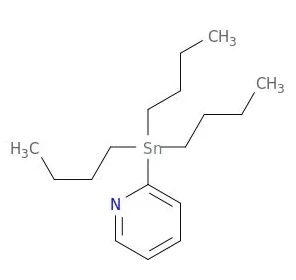- This topic is empty.
-
AuthorPosts
-
05/09/2025 at 15:19 #87181
2-(TRIBUTYLSTANNYL)PYRIDINE (CAS No.: 17997-47-6) is a highly valuable organotin compound that plays a critical role in organic synthesis, catalysis, nanomaterials, and functional material development. With its transparent yellow liquid appearance, molecular formula C17H31NSn, and molecular weight of 368.14 g/mol, this reagent has become indispensable in advanced chemical research and industrial applications.
As a versatile intermediate, 2-(TRIBUTYLSTANNYL)PYRIDINE (CAS No.: 17997-47-6) combines the reactivity of tin-based functional groups with the aromatic pyridine ring, making it a unique compound for synthetic chemists, material scientists, and pharmaceutical researchers. In this blog post, as high quality organic fine chemicals manufacturing factory, SACH will share the physical and chemical properties of 2-(TRIBUTYLSTANNYL)PYRIDINE for sale, as well as its synthesis methods, etc.

Physical and Chemical Properties of 2-(TRIBUTYLSTANNYL)PYRIDINE
* Appearance: Transparent yellow liquid
* Density: 1.15 g/cm³
* Melting Point: 132–135 °C
* Boiling Point: 134 °C
* Purity Standard: 98% minimum
* Packaging: 25 kgs/drum
* Storage Conditions: -20 °C for optimal stability
These properties allow the compound to maintain chemical integrity during transportation and long-term storage, ensuring reliability in laboratory and industrial settings.
Synthesis Method of 2-(TRIBUTYLSTANNYL)PYRIDINE
1. Formation of Grignard Reagent:
Halogenated hydrocarbons are reacted with magnesium in anhydrous ether, producing a Grignard reagent.
2. Reaction with Tributylpyridyltin:
The Grignard reagent is introduced to tributylpyridyltin, allowing nucleophilic substitution to occur.
3. Post-treatment and Purification:
The reaction mixture is carefully processed to isolate 2-(TRIBUTYLSTANNYL)PYRIDINE with high purity.
This method ensures efficient yields while maintaining the structural stability of the pyridine group and the stannyl substituent.
Role of 2-(TRIBUTYLSTANNYL)PYRIDINE in Organic Synthesis
* Drug Development: It acts as a precursor for pharmaceutical compounds containing pyridine frameworks, commonly found in antibiotics, anti-inflammatory agents, and central nervous system drugs.
* Pesticide Intermediates: The compound is useful in synthesizing agrochemicals that require high selectivity and stability.
* Flavor and Fragrance Chemistry: In fine chemical industries, it enables the controlled synthesis of pyridine-containing aromatic compounds used in spices and perfumes.
By enabling selective reactions, 2-(TRIBUTYLSTANNYL)PYRIDINE helps chemists design molecules with high structural precision.
2-(TRIBUTYLSTANNYL)PYRIDINE as Catalyst
* Esterification Reactions: Enhances reaction speed and yield by stabilizing transition states.
* Etherification Processes: Provides better selectivity, particularly in aromatic ether formations.
* Carbonyl Chemistry (Ketation): Facilitates ketone synthesis through efficient bond activation.
As a catalyst, this compound increases process efficiency, reduces energy consumption, and minimizes the use of harsher reagents, aligning with sustainable chemistry goals.
Application of 2-(TRIBUTYLSTANNYL)PYRIDINE in Nanomaterials
* Quantum Dots and Nanowires: Used as a ligand or reactive agent to control nanostructure growth.
* Surface Modification: Enhances performance and stability of nanoparticles by coordinating with metal centers.
* Tailored Properties: Allows researchers to adjust optical, magnetic, or electronic properties of nanomaterials.
By introducing organotin-pyridine structures, scientists can develop high-performance nanomaterials for electronics, energy storage, and biomedical applications.
Optoelectronic Materials Based on 2-(TRIBUTYLSTANNYL)PYRIDINE
Another important area of application is in optoelectronic material synthesis.
* OLEDs (Organic Light-Emitting Diodes): Serves as a precursor for light-emitting materials, improving brightness and efficiency.
* Organic Photovoltaics: Contributes to charge transport layers, enhancing energy conversion in solar cells.
* Electroluminescent Devices: Enables new generations of thin, flexible, and durable optoelectronic devices.
As demand for efficient and sustainable energy solutions grows, the role of 2-(TRIBUTYLSTANNYL)PYRIDINE in optoelectronic research will expand further.
Coordination Chemistry and 2-(TRIBUTYLSTANNYL)PYRIDINE
* Formation of Coordination Complexes: The pyridine nitrogen acts as a donor site, while the stannyl group influences structural properties.
* Unique Geometries: Such complexes often display novel electronic and magnetic characteristics.
* Functional Materials: Coordination compounds derived from 2-(TRIBUTYLSTANNYL)PYRIDINE are studied for applications in catalysis, molecular recognition, and advanced material design.
This dual nature—combining organotin and pyridine reactivity—makes it an ideal building block in metallorganic research.
Safe Handling and Storage of 2-(TRIBUTYLSTANNYL)PYRIDINE
* Storage: Keep at -20 °C in tightly sealed containers to prevent decomposition.
* Personal Protection: Laboratory use requires gloves, goggles, and protective clothing.
* Waste Disposal: Must follow strict chemical waste regulations due to organotin environmental sensitivity.
Adhering to these guidelines ensures both researcher safety and regulatory compliance.
Conclusion
2-(TRIBUTYLSTANNYL)PYRIDINE (CAS No.: 17997-47-6) is not only a synthetic intermediate but also a catalyst, nanomaterial precursor, and optoelectronic material contributor. Its ability to integrate pyridine chemistry with organotin reactivity provides unique advantages across diverse industries.
-
AuthorPosts
- You must be logged in to reply to this topic.